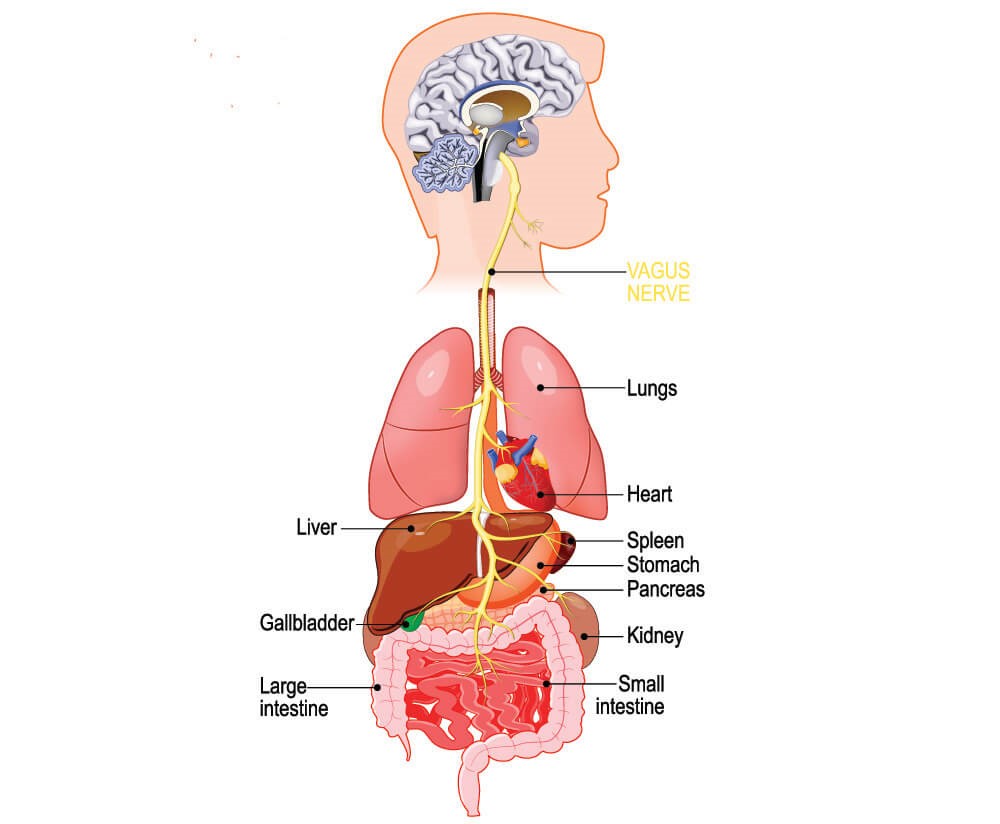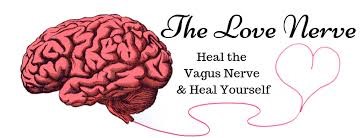The body’s initial reaction to a crisis or threatening situation is to activate the “fight or flight” stress response, in which the sympathetic nervous system primes the body to take either confrontational or avoidance action. In facing an emergency, the body releases first adrenalin and then cortisol to enable the body to deal with acute stressful situations. (However, when stressful situations become chronic in nature, continuously elevated levels of cortisol become harmful to physical and mental health.)
Once the threat has passed, the “rest and digest” response takes over, in which the vagus nerve – as part of the parasympathetic nervous system – plays a major role by telling the body to chill out.
Role of the vagus nerve in stress:
The word “vagus” means “wanderer” in Latin, which describes how the longest nerve in the body wanders all over the body to link various organs bidirectionally with the brain. The vagus nerve is responsible for regulating the functions of internal organs, such as heart rate, respiratory rate, and digestion. The most important function of the vagus nerve is to convey information from the internal organs, such as the heart, lungs, liver, and gut, to the brain. The gut is a particularly important sensory organ, due to the large surface that is exposed to the outside world.
As part of the parasympathetic nervous system, the vagal response (“rest and digest”) reduces stress and as such reduces heart rate and blood pressure, while stimulating digestion, which are typically what happens when we are relaxed.
The effectiveness of the “rest and digest” reaction depends on how well or how poor the vagus nerve functions. The internal biological process that represents the activity of the vagus nerve is called “vagal tone”. Low vagal tone means poor vagal activity, while people with a stronger vagus response will recover more quickly after stressful events. You may be genetically predisposed to high or low vagal tone, but low vagal tone can be addressed.
Vagal tone is measured by comparing the difference in your heart rate between breathing in or out. The heart rate increases slightly when you breathe in and slows down a little when you breathe out. The bigger the difference between inhalation heat rate and exhalation heart rate, the higher the vagal tone, and the faster the body will relax after a stressful event.
Poor vagal tone is associated with inflammatory conditions, including all autoimmune diseases, poor cardiovascular health, stroke, depression, diabetes, cognitive impairment, chronic fatigue syndrome, and anxiety.
High vagal tone plays an important part in the functioning of the body, as the vagus nerve facilitates two-way communication between the brain and organs in the body. High vagal tone is associated with improvements in the functioning of important body systems, such as better blood sugar regulation, lower blood pressure, a reduced risk of cardiovascular disease and stroke, and improved digestion. In terms of dealing with stress, high vagal tone is associated with better mood, less anxiety, and more stress resilience – the ability to adapt to stressful situations. The more you increase your vagal tone, the more your physical and mental health will improve.

Activities to increase vagal tone:
If your vagal tone is low, there are steps to be taken to improve your vagal tone. By learning how to improve your vagal tone through stimulation of the vagus nerve, you can shut down the stress response as soon as it is not required. Stimulation of the vagus nerve for its therapeutic effect, however, require regular practice.
Certain mind-body activities and practices can stimulate the vagus nerve to increase its activities and improve vagal tone:
- Visceral manipulation enables trained practitioners to interface directly and indirectly with the vagus nerve as it exits the skull and at various locations in the bodies of patients. This vagal intervention treatment not only shuts down the stress response, but also restores the normal mobility and functionality of our internal organs, glands and deep nerve pathways, says Richard Sutton (international health and performance educator and consultant, amongst others for tennis star Kevin Anderson and the Chinese Olympics team).
- Massage therapy can increase vagal activity through the stimulation of pressure receptors in the muscular and skeletal system. Massage therapy can alleviate stress by stimulating the increased release of serotonin and dopamine, while the release of cortisol is reduced.
- Slow and deep breathing exercises are known to increase vagal tone and parasympathetic activity, while reducing adrenalin and cortisol levels.
- Swimming and submergence in water activates the vagus nerve and the activation is amplified in cold water, for example by finishing off your shower with at least 30 seconds of cold water.
- Immersion of the face in cold water for one to three minutes is a potent trigger for vagus nerve activity. This is a quick and easy activity to help manage stressful situations.
- Yoga can be useful to manage stress, as studies have indicated increased vagal activity during yoga practice. Yoga practice also leads to reductions in cortisol levels, largely due to increased vagal tone.
- Meditation is recognized as one of the oldest methods of managing stress and studies have shown that the practice of mindfulness meditation is associated with increased vagal tone and positive emotions. Meditation can reduce many of the adverse effects of chronic stress.
- “If music be the food of love, play on; give me excess of it” wrote Shakespeare, realizing the potential of music to alter our mood and mental aptitudes. Different music tempos affect our physical abilities, and can act motivational, for example, can improve, while exercising, the time to exhaustion. Research has indicated that music influences the release of stress hormones and chemicals in the brain, such as serotonin, dopamine, cortisol, and oxytocin. Vagal tone is enhanced through exposure to enjoyable music.
- As the vagus nerve is connected to your vocal cords and the muscles at the back of your throat, activating these muscles by singing, humming, chanting, and even gargling, can stimulate the vagus nerve.
Apart from these mind-body interventions, lifestyle factors such as diet and exercise, play an important role in general health, including vagal tone. For example, the presence of healthy bacteria in the gut is known to create a positive feedback loop through the vagus nerve to the brain, increasing vagal tone in the process. Exercise also stimulates the vagus nerve, contributing to the beneficial brain and mental health effects of exercise.
Stimulating your vagus nerve is a sure way of telling your body that it is time to relax and de-stress.

Sources:
The Stress Code. From surviving to thriving. Author: Richard Sutton. Published 2018, Pan Macmillan South Africa. P 318.
Vagus nerve as modulator of the brain-gut axis in psychiatric and inflammatory disorders. Published 13 March 2018. Frontiers in Psychiatry. US National Library for Medicine. National Institutes of Health. (www.ncbi.nlm.nih.gov/pmc/articles)
How to stimulate your vagus nerve for better mental health. Published 21 January 2017. Student Academic Success Service. University of Ottowa. (www.sass.uottowa.ca)
6 Ways to instantly stimulate your vagus nerve to relieve inflammation, depression, migraines and more. Published online. Institute for Affordable Health Care. (www.iahc.com)
HEALTH INSIGHT
